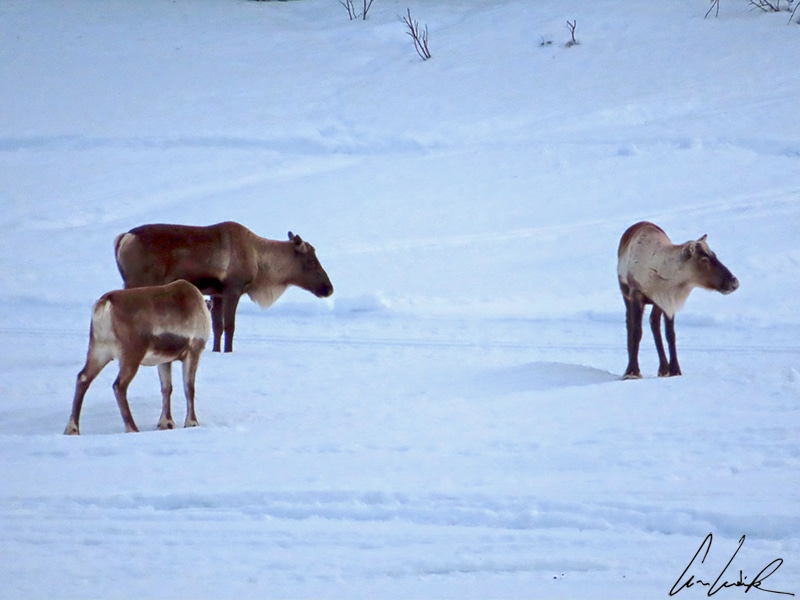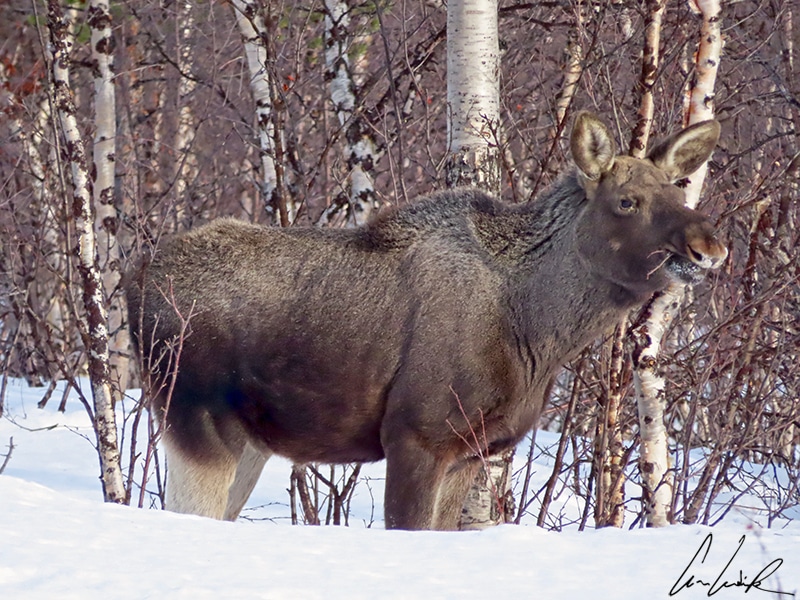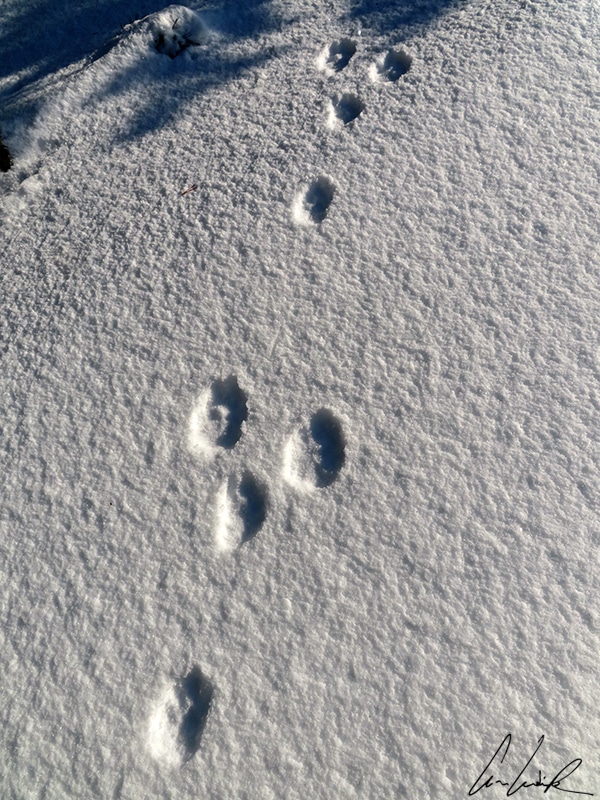- 1 The reindeer, Santa’s favorite animal
- 2 His Majesty the wolf, a Lappish predator
- 3 The elk or moose, the king of the Nordic forests
- 4 The Wolverine: the most ferocious animal of the Great North
- 5 The brown bear, the Finnish national animal
- 6 The lynx, a small cat perfectly adapted to the icy North
- 7 The mountain hare, the king of polar camouflage
- 8 The polar fox, the Arctic in the skin
- 9 The white partridge, an expert in camouflage
- 10 The Snowy Owl, a raptor of the Arctic lands
The reindeer, Santa’s favorite animal
The reindeer (Rangifer tarandus) is the symbolic animal of Lapland. The reindeer is also known as the caribou in North America. With his long snout, majestic antlers, and massive chest he looks ready to pull Santa’s sleigh – think especially of Rudolph and his red nose! His height varies from 70 to 83 inches, and its weight can reach 552 lbs. for males and 330 lbs. for females. The reindeer is unique among the Cervidae family in that females also grow antlers. The reindeer is the only semi-domesticated deer. It roams freely and unconstrained in large groups over vast territories and provides food and clothing for Arctic peoples. Reindeer are resistant to the cold and can survive temperatures as low as -40°F ! Do you know that -40°C is equal to -40°F ? To find food, and in particular, the lichen « Cetraria islandica », which they love, reindeer can travel several thousand miles per year. The « Cetraria islandica » contains 60% carbohydrates. It provides the reindeer with the calories it needs to fight the cold.

Reindeer in Lapland
Wolf packs are the most formidable predators of reindeer, especially during transhumance. Reindeer defend themselves by fleeing. As enduring runners, they can maintain a speed of 25 mph for almost an hour.
His Majesty the wolf, a Lappish predator
Of the three predators, bears, wolves, and wolverines, that inhabit Lapland, the gray wolf (Canis lupus) is the most disliked. It is feared and hunted – killed because of the damage it causes to reindeer farms. As a result, wolves have come close to extinction. Today, the wolf population is estimated at 250 individuals, with packs sometimes visible in Karelia, in eastern Finland, near the Russian border. Despite European protection actions and opposition from animal rights organizations, wolves continue to be hunted in Finland, Sweden, and Norway today. As a result, wolves have remained extremely shy and often make only brief and furtive appearances. Observing them is a treat reserved for only the luckiest of people.
« Let’s stroll in the woods
While the wolf isn’t here
If the wolf was here
He would eat us
But since he’s not here
He won’t eat us
Wolf, are you here ? Do you hear ? What are you doing »
(Nursery rhyme)
The gray wolf has a robust morphology that resembles that of a German shepherd. Its fur adopts a different density and color depending on the environment in which it evolves. Its jaw is powerful and can close with the force of 150 kg/cm² (for comparison, a dog’s is 60 kg/cm²). Its long and thin legs are made for endurance running with maximum speeds reaching 25 to 31 mph. Wolves can travel an average of 38 miles per night. They live in packs organized in a hierarchy dictated by a dominant couple (the alpha male and female) which are generally the only pair to procreate. Wolves have very acute hearing and are able to hear sounds up to 40 kHz (compared to 20 kHz in humans) over a distance of 4 to 6 miles. A wolf’s sense of smell is also exceptionally sharp; it can detect an animal at a distance of 300 yards even against the wind. Even if its vision is not very good during the day, its field of vision is 250° (against 180° for man). On the other hand, its eyes are lined, like those of cats, with a layer of tissue behind the retina called the « tapetum lucidum », conferring excellent vision at night.

Old wolf from Lapland interviewed by C-Ludik
The elk or moose, the king of the Nordic forests
The moose in North America or the elk in Eurasia (Alces alces) is an impressive animal, but it is challenging to come across. It is the largest and heaviest in the deer family. The moose (äld in Swedish) is a large, shy animal that stays hidden all day long in the heart of Lapland’s forests. It ventures out only at dawn and dusk to graze in the marshes and meadows. The moose is a browsing herbivorecapable of consuming many terrestrial and aquatic plants. With its tall body perched on long, slender legs and its enlarged, webbed hooves, the most prominent member of the deer family moves effortlessly through the water. The moose can negotiate fallen trees or snowdrifts that would make a deer or wolf cringe. The male or bull is twice as heavy as the female; the head-and-body length is 7 feet 10 in. – 10 feet 2 in. with the vestigial tail adding only a further 2-4 ½ in. He weighs between 1,200 and 1,550 lbs. The female or cow typically weighs 440 to 1,080 lbs. The male has distinctive board, palmate antlers weighing up to 45 lbs, and a dewlap or bell, a fold of skin hanging under the chin.

The moose or Elk in Swedish Lapland
Unlike most deer species, the moose or elk is a solitary and relatively placid animal. Although generally slow-moving and sedentary, it can become aggressive during the mating season. If harassed or startled, the moose may become very aggressive and charge without warning. Elk or moose attacks are more numerous than bear attacks! And they are difficult to escape because they can run at a top speed of 35 mph ! The moose is also able to swim hundreds of feet across large rivers. And thanks to its obdurate nostrils, it can remain in apnea for a few moments in search of the aquatic plants it loves.
The Wolverine: the most ferocious animal of the Great North
The Wolverine is also referred to as the glutton, carcajou, or quick hatch. At first glance, the Wolverine (Gulo gulo) may seem cute. He looks like a small bear with a large head, rounded ears embroidered with beige, a chocolate coat, and short and strong legs with large semi-retractable claws. The adult wolverine is the size of a medium size dog, with a body length ranging from 26-44 inches and weighing 24-40 lb. However, one should be cautious despite the rather friendly appearance of the Wolverine. Although modest in size, it is one of the most ferocious animals in Lapland ! His Finnish name is « Ahma ». The Wolverine has thick dark soft oily fur, which is hydrophobic. Just like the adamantium-clawed hero he inspired, the Wolverine is formidable and not afraid to fight alone against tougher opponents like lynxes or wolves. This carnivore is the largest of the mustelid family, a giant cousin of the weasel and the beech marten. Solitary and enduring, it is a true predator that can chase its prey over 25 miles but is also a scavenger. If it finds a carcass on its way, it will not hesitate to fight to eat it… even against a bear. Equipped with fearsome jaws, its reputation for ferocity is a reality. It attacks rodents, hares, foxes, birds, and animals much bigger than itself, such as wolves, reindeer, or elk !
The brown bear, the Finnish national animal
The brown bear (Ursus arctos) is, without a doubt, the largest predator in Lapland, weighing over 660 lbs. The brown bear, or « Karhu » in Finnish, occupies a prominent place in Finnish mythology, particularly in the Kalevala (Finnish national epic), which has inspired many artists. Bears were considered sacred animals and were honored with admiration and respect. The bear is still considered the king of the forest by the Finnish population. Bears are highly distrustful of humans, so the probability of facing a bear in the wild is almost zero! But then, who is this man who saw a man who saw a bear? To have a chance to observe this very discreet predator, nature lovers will have to go to the regions where their population is greater (1,000 to 1,500 bears): the forests of Eastern Finland bordering Russia.
« Mr. Bear, wake up,
You have slept too much.
On the count of three, wake up !
One, two, three!
Mr. Bear
Are you sleeping or going out ?
Zzzzzz… I’m sleeping ! »
(Nursery rhyme)
The first bears appear in April when the snow melts, and they become more and more numerous during May, although they are still not very active. During the rutting period from the end of May to mid-June, several males can be observed fighting or at least intimidating each other with growls that roar through the forest! In August and September, they urgently need to store fat for the winter by eating meat and fish. From October onwards, bears head for the Russian border to dig a den well out of sight.
The lynx, a small cat perfectly adapted to the icy North
The boreal lynx (Lynx lynx) is challenging to observe because it is so discreet. Mysterious and invisible, it is most likely to be seen at dawn and dusk when it is active, provided that you are incredibly patient. Lynxes are challenging to spot, however, as their excellent senses of sight, smell, and hearing (they can hear deer from 1,500 feet away) tell them to stay away from humans. This feline is recognizable by its black and gray spotted fur, short black-tipped tail, and « brushes » (tufts of hair) on the tips of its ears. It measures between 32 and 51 inches in length and weighs 45 lbs on average. Its large paws and plantar surface covered with hair prevent it from sinking into the snow… as if it were wearing snowshoes ! Lynxes are carnivores that feed on hares, rodents, young reindeer or roe deer, and birds (grouse, partridge…). This solitary animal living in large areas is a nocturnal hunter who does not have a fixed home and kills its prey by asphyxiation by biting its throat. At night the lynx sees very well thanks to the layer of tissue behind the retina, the « tapedum lucidum », which reflects the ambient light. I am not teaching you anything: the expression « To have the eye of a lynx » means that one has excellent sight, does not it ? But do you know where this expression comes from ? This expression has nothing to do with our little feline ! It comes from Greek mythology; Lynceus was a Messenian prince and one of the Argonauts who was the pilot on Jason’s ship Argo in his quest for the Golden Fleece. According to legend, Lynceus was said to have a sharp eye, enabling him to see through clouds and walls. The expression « to have the eye of Lynceus » was gradually transformed into « to have an eye of a lynx ».
The mountain hare, the king of polar camouflage
The mountain hare (Lepus timidis) also known as the blue hare or tundra hare, has the particularity of changing the color of its coat to blend in with the landscape. This strategy is called homochromy. In Lapland in winter, the mountain hare is white as snow except for the tips of its ears which remain black. In spring, the brown hairs reappear to give him the same color as a common hare, except for his tail, which always remains white. The mountain hare does not fear the harshness of the climate. It has a less elongated and rounder body than its cousin, the brown hare, which results in less heat loss (it curls up into a ball!). Its dense winter coat protects it well from the cold, and its large hairy legs act like snow shoes.

Mountain hare tracks in the snow in Lapland
The hare is a very discreet animal that moves only at night and stays hidden in a rock or a stump during the day. It is challenging to see, but we can easily spot its tracks in the snow, in the shape of a Y, and its droppings, small round balls composed mainly of dry grass. Small question about the picture above… Which way is the hare moving ? Towards the top of the photograph or the bottom ? Come on; I’ll give you a little clue: the hare only moves by jumping ! While hopping, the hare first puts its two front legs, one in front of the other, on the ground. Then it brings its two back legs, which flatten out on the ground (the longer tracks), up on either side of the front legs and a little in front of them. So, have you found the direction of travel ?
The polar fox, the Arctic in the skin
The Arctic fox (Vulpes Lagopus,) also known as the white fox, polar fox, or snow fox is a small fox of the Arctic. It adapts its fur to the seasons to suit the environment and climate of Lapland. Its thick warm fur is used as camouflage. Generally, its fur is dark brown in the summer and turns immaculate white in the winter. It is an incredibly hardy animal that can survive temperatures as low as -58°F. The polar fox wraps its large and fluffy tail around itself like a scarf to cope with this cold by preventing heat loss. The polar fox has a body length between 20 and 30 inches and weighs 11 to 20 lbs. It has hairy paws that allow it to move easily on snow or ice, excellent hearing, and a very developed sense of smell. The Arctic fox can easily locate prey hidden under 4 and 5 inches of snow. It is extraordinarily enduring and can travel hundreds of miles for food. Arctic foxes eat small animals, lemmings, polar hares, young seals, birds, eggs, carrion, or even berries. In winter, when food is scarce, this cunning little creature will follow a polar bear because the latter usually eats only the fatty parts of its prey. The table scraps are for him ! The Arctic fox is also cunning in managing its dens, which are used from generation to generation. According to some scientists, dens have been used for more than a hundred years and may have dozens of entrances and exits. Digging in the permafrost is difficult, so foxes tend to reuse their dens! Perhaps this little animal is as clever as the expression « sly as a fox » implies.
The white partridge, an expert in camouflage
Here is a partridge dressed in white in Lapland, with a jet-black beak and tail ! However, the white partridge (Lagopus Lagopus) is not a partridge and is not white all year round. Its scientific name is Willow Ptarmigan, also known as a white goose. Its plumage varies with the seasons to match its environment. This Willow Ptarmigan changes color three times during the year. In winter, males and females are entirely white, so as to remain unnoticed on the snow, except for the tail, which remains black all year. In summer, the plumage is brown with a reddish hue on the neck and breast, a black tail, and white wings and underparts. The Willow Ptarmigan varies in length between 14 and 17 inches, with a wingspan between 24-26 inches. Its weight is 15 to 29 oz.

The white partridge in the snow in Lapland
The Willow Ptarmigan is adapted to frigid weather. It stays in the Arctic regions all year round, frequenting the dwarf willow groves in the tundra. The adults are herbivorous, eating buds, leaves, seeds, and berries during the summer. It feeds off twigs of willows, which give the bird its name. The ptarmigan’s feathered toes make walking in the snow effortless. Feathered, the legs seem a little out of proportion to its body.
The Snowy Owl, a raptor of the Arctic lands
In Lapland, the Snowy Owl (Bubo scandiacus) has a unique adaptation to its habitat. Most owls are nocturnal, sleeping during the day and hunting at night, but the Snowy owl is active night and day, especially during summertime. It can hunt lemmings 24 hours a day! Such an adaptation is not surprising, however, when one considers that, in the Arctic Circle, the sun never sets during the summer! The Snowy owl is primarily white with black stripes that make camouflage easy against snow and allow it to catch its prey by surprise. Capture usually occurs after a short flight from a perch. Its powerful curved claws, about 1 inch long, can quickly reduce even the largest prey to helplessness. Although it feeds mainly on small rodents, its favorite food is the lemming. The Snowy Owl is an opportunistic hunter: it eats Arctic hares and birds (ptarmigan, bunting, duck, or pheasant) when they are available. The Snowy Owl swallows its prey like all birds of prey. Then 18 to 24 hours later, it regurgitates what has not been digested: bones, teeth, fur, and indigestible feathers are compressed into oval pellets.
« Harry’s Hedwig
Is beautiful
Flies all over the world
She travel’s to Ron’s and Hermione’s
To deliver their owl post» .
(The City Of Prague Philharmonic Orchestra – Hedwig’s Theme – Harry Potter Philosopher’s Stone)

The Snowy Owl in Lapland
Did you know? Hedwig, who accompanied Harry Potter for a long time, is also an owl. The bird as imagined by J. K. Rowling is also known as the polar owl, the white owl, or the arctic owl. The Arctic owl is the heaviest of the Strigidae. The snowy owl is a large bird, measuring between 20 and 25 inches in length, with a wingspan ranging from 3 to 5 feet. The average weight is 4.5 lb. Native to the Arctic tundra, the snowy owl is endowed with a thick down, covered with abundant feathers, including its legs and toes, which insulate it from the cold. This particularity allows the Snowy owl to withstand freezing temperatures up to -58°F. The insulation keeps his body temperature between 100.4 and 104°F.

